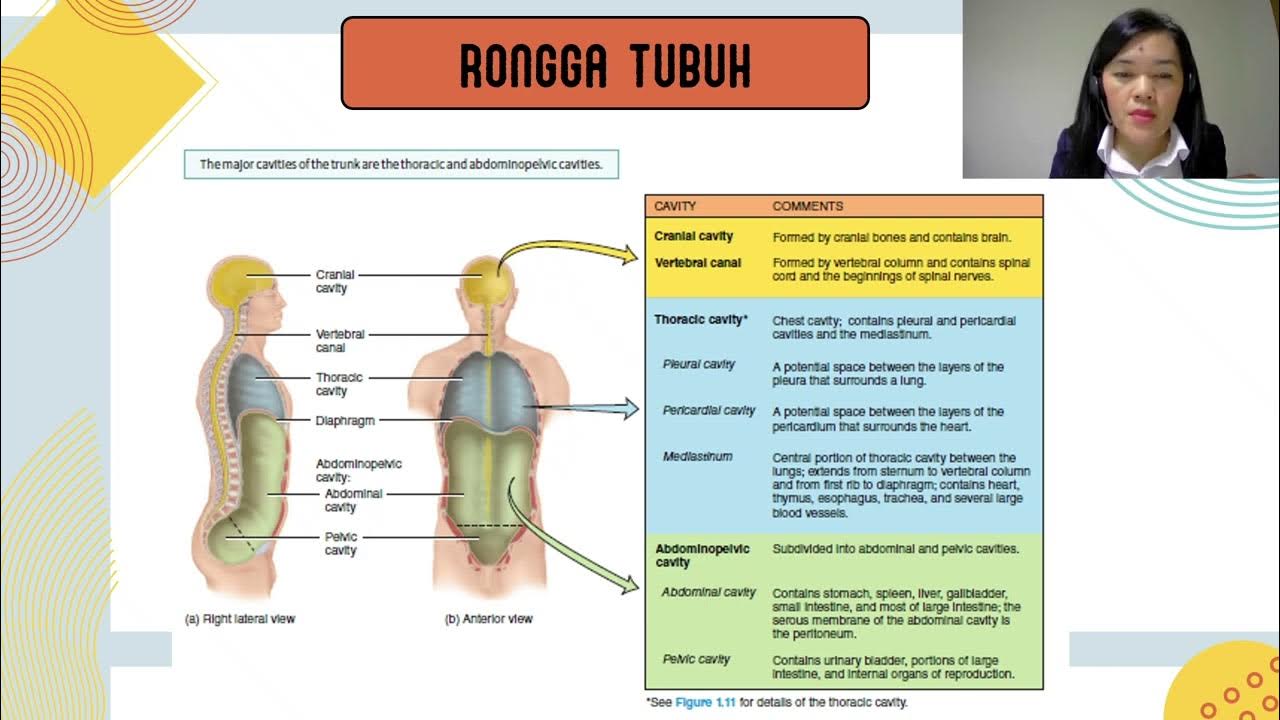Body Cavities and Membranes: Drawn and Defined [Anatomy Physiology]
Summary
TLDRThis educational video simplifies the concept of body cavities and their associated membranes. It explains the dorsal and ventral cavities, further dividing them into the cranial, spinal, thoracic, and abdominopelvic sections. Each cavity's function and the organs it contains are detailed, along with the protective role of membranes like the meninges, pleura, pericardium, and peritoneum. The video uses a flow chart and table for clear summarization, making complex anatomy accessible and engaging.
Takeaways
- 🧠 The body has two main cavities: the dorsal cavity and the ventral cavity, which house various organs and structures.
- 🌟 The dorsal cavity is located in the back of the body and can be further divided into the cranial cavity (housing the brain) and the spinal cavity (housing the spinal cord).
- 🛡️ The meninges are a three-layer membrane that lines the cranial cavity, consisting of the dura mater, arachnoid, and pia mater, protecting the brain.
- 💧 Both the cranial and spinal cavities contain cerebrospinal fluid (CSF), which cushions and protects the brain and spinal cord.
- 🫁 The ventral cavity is located in the front of the body and includes the thoracic cavity (containing the heart and lungs) and the abdominopelvic cavity.
- 🩺 The thoracic cavity is subdivided into the pleural cavities, surrounding the lungs, and the mediastinum, containing the heart and other structures.
- 🫁💧 Pleural fluid in the pleural cavities lubricates the lungs and the pleura, a double-layered membrane lining the lungs and chest wall.
- ❤️ The pericardial cavity within the mediastinum surrounds the heart and contains pericardial fluid, which lubricates the heart.
- 🔁 The abdominopelvic cavity, below the diaphragm, consists of the abdominal cavity (containing organs like the liver and intestines) and the pelvic cavity (housing the bladder and reproductive organs).
- ➡️ The peritoneum is the membrane lining the abdominal cavity, with the visceral peritoneum covering organs and the parietal peritoneum lining the cavity walls, containing peritoneal fluid.
Q & A
What is a body cavity and what is its primary function?
-A body cavity is a space or compartment within the body that houses organs or structures. Its primary function is to provide a protective environment for the organs it contains.
How many main body cavities are there in the human body, and what are they called?
-There are two main body cavities in the human body: the dorsal cavity and the ventral cavity.
What is the dorsal cavity and what are its main subdivisions?
-The dorsal cavity is the cavity located in the back of the body. It can be subdivided into the cranial cavity, which houses the brain, and the spinal cavity, which houses the spinal cord.
What is the ventral cavity and how is it further divided?
-The ventral cavity is the cavity located in the front of the body. It is further divided into the thoracic cavity and the abdominopelvic cavity, which are separated by the diaphragm.
What are the two main parts of the dorsal cavity and what do they contain?
-The two main parts of the dorsal cavity are the cranial cavity, which contains the brain, and the spinal cavity, which contains the spinal cord.
What is the function of cerebrospinal fluid (CSF) in the cranial and spinal cavities?
-Cerebrospinal fluid (CSF) in the cranial and spinal cavities helps protect and cushion the brain and spinal cord, respectively.
What are the three layers of the meninges that line the cranial cavity?
-The three layers of the meninges that line the cranial cavity are the dura mater, arachnoid, and pia mater.
What is the mediastinum and what does it contain?
-The mediastinum is the middle portion of the thoracic cavity and it contains the heart, trachea, esophagus, great vessels, and thymus gland.
What is the difference between the pleural cavities and the mediastinum?
-The pleural cavities are the parts of the thoracic cavity that surround the lungs and are lined by the pleura, while the mediastinum is the central part of the thoracic cavity that contains the heart and other structures.
What is the pericardial cavity and what does it contain?
-The pericardial cavity is a cavity within the mediastinum that surrounds the heart. It contains a small amount of fluid called pericardial fluid and is lined by a double-layered serous membrane called the pericardium.
How does the abdominopelvic cavity differ from the abdominal cavity?
-The abdominopelvic cavity is the inferior portion of the ventral cavity, which includes both the abdominal and pelvic cavities. The abdominal cavity is the superior part of the abdominopelvic cavity and contains organs such as the liver, stomach, and intestines.
What is the pelvic cavity and what organs does it house?
-The pelvic cavity is the inferior portion of the ventral cavity, enclosed by the pelvis and pelvic floor muscles. It houses the urinary bladder, reproductive organs, pelvic portion of the colon, and rectum.
Outlines

Cette section est réservée aux utilisateurs payants. Améliorez votre compte pour accéder à cette section.
Améliorer maintenantMindmap

Cette section est réservée aux utilisateurs payants. Améliorez votre compte pour accéder à cette section.
Améliorer maintenantKeywords

Cette section est réservée aux utilisateurs payants. Améliorez votre compte pour accéder à cette section.
Améliorer maintenantHighlights

Cette section est réservée aux utilisateurs payants. Améliorez votre compte pour accéder à cette section.
Améliorer maintenantTranscripts

Cette section est réservée aux utilisateurs payants. Améliorez votre compte pour accéder à cette section.
Améliorer maintenant5.0 / 5 (0 votes)






